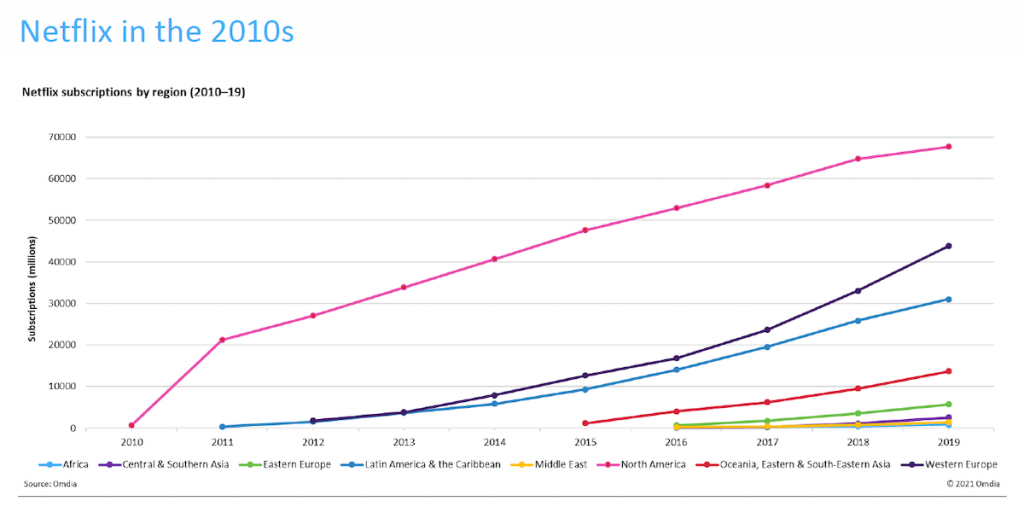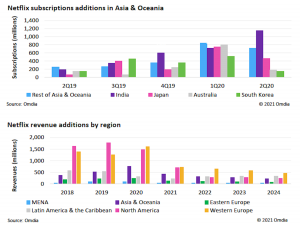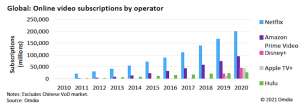
After more than 35 years of operation, TBI is closing its doors and our website will no longer be updated daily. Thank you for all of your support.
TBI Tech & Analysis: How Netflix can thrive in the 2020s
Netflix has established itself as the global SVOD success story, but new entrants surged into the market during 2020 and it now faces a much-changed landscape in the decade ahead. Rob Moyser, senior analyst for TV & online video at TBI sibling OMDIA, provides his assessment of where the streamer needs to invest to ensure its future growth.
Netflix is well established as the world’s leading online video service. However, with familiar competitor Amazon Prime still expanding and new content-rich players like Disney+ entering the market to provide yet more competition, it is clear that Netflix cannot stand still and expect to thrive.
Local content & the Indian example
As Netflix grew and expanded into different markets over the past decade, it began to compete against local services, many of whom were being supplied by domestic production companies with content proven to be popular to homegrown consumers.
To gain further footholds in these countries and lessen the cost of acquiring local content from other companies, it began to produce its own local content originals with many shows becoming major hits across multiple markets.
In 2020, this strategy has become a key feature in enticing new subscribers and retaining old ones, with Netflix continuing to set up new production houses in several markets including the UK (2019), France (2020), and Italy (2020). As growth begins to saturate in the forthcoming years in markets across Europe and the US, Netflix has started to push its local production spending into other global markets, including Asia, to drive growth in the huge consumer markets present there.
India, in particular, has been of great interest to Netflix lately, with the company spending $400m in the country alone since 2019, developing original content as well as licensing other content. It has gained a foothold there, despite heavy investment from other global players such as Amazon Prime and local players such as Eros Now.
This focus on local content in India is of particular importance to the company as it considers localisation and “differentiated content” vital to reaching a broader set of Indian consumers, especially those outside the large cities, while also having the added benefit of appealing to consumers outside India, particularly across Asian and Middle Eastern countries.
Content differentiation & the Studio Ghibli deal
As it seeks more subscribers, Netflix will need to diversify its content even more, with commissions from a broad range of sources to appeal to as many consumer interests and tastes as possible.
Alongside its significant move into film animation production, in January 2020 Netflix bought the distribution rights to one of the globe’s most popular animation houses, Studio Ghibli.
The deal, which was signed in anticipation of Disney’s entry into the European streaming market with its new VoD service Disney+ in March 2020, gave Netflix exclusive rights to show its films in Africa, Asia & Oceania, Europe, Latin America, and the Middle East. It, however, did not receive rights for distribution in the US as HBO had already partnered with the company beforehand to use the rights for its HBO Max service, which launched there in May 2020.
The agreement with Studio Ghibli is particularly important for several reasons. For one, it broadens Netflix’s appeal in a rapidly growing market in Asia and serves the global demand for Studio Ghibli films, which to date have mostly been available via physical release only.
The deal will also enhance its position in Japan itself, where the company is seeing significant potential for growth, providing Netflix with a massive advantage over competitors like Disney, which is also seeking to make strong inroads there.
It’s also worth noting that prior to this deal, Netflix signed amp agreement with existing partner Nickelodeon (owned by ViacomCBS) to produce original animated film and TV content in November 2019. These deals may, however, be compromised in the near future as the recently merged ViacomCBS prepares its own streaming service that will include content from Nickelodeon and DreamWorks Animation.
Making the most of mobile
As subscriber saturation point is reached in North America and other established regions, Netflix is increasingly looking to tap into new areas for revenue from the growing streaming market.
The method of Netflix’s strong inroads into India, and other markets in the region, stand in stark contrast to its previous entries into new territories, with the company pushing mobile-only plans as a consequence of these countries having a heavy reliance on mobile for internet connection.
This emphasis was illustrated by its partnership with Indian telco giant Jioin July 2019, which provided customers free subscription to Netflix with Jio’s bundled offers, a deal that in 2020 is estimated to have helped Netflix gain an estimated 4.6 million paid subscribers. This strategy started to succeed during the first two quarters of 2020 where net subscriptions went up by 1.8 million, just under a third (30%) of the whole region, with 2.8 million set to be added by year end.
Despite having a strong foot in the region, Netflix still faces stiff competition from its US rival Amazon. In India, for example, Amazon is the third-largest OTT operator and has invested heavily across the region in recent years. Likewise, local Indian OTT services such as Hotstar hold premium exclusive online rights to popular Indian content such as the cricket Premier League (IPL), Fox, and HBO content, all helping the service maintain popularity.
In addition to this, Disney has already made a massive splash in India, becoming the second-largest OTT player in just one year with 9.5 million customers, while its recent bundling of Disney+ with Hotstar Premium will only serve to strengthen the company’s position in India’s crowded online video market.
It is important to also note that Netflix’s inroads into Asia will not generate the same level of income as in other regions, with package prices far lower compared to other markets globally. This is despite 2020 being the best year of growth in Asia & Oceania so far, with the region mainly growing in revenue in 2020 after prices rose in Australia.
Rob Moyser is senior analyst for TV & online video at OMDIA, the global research powerhouse which, like TBI, is part of Informa. The excerpt above is from his recent report titled ‘Netflix: Strategies for the 2020s’.







